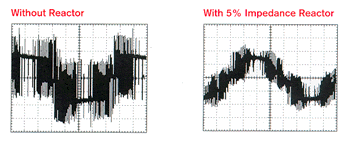AMAZON multi-meters discounts AMAZON oscilloscope discounts
Can variable-frequency drives (VFDs) also save power at full load?
Short answer: There are losses associated with drives of approximately 4%. If the motor is running at full speed and full load via a variable-speed drive, the power drawn from the supply will be higher than that of any other form of starter.
Why do some inverters (VFDs) needs a reactor (commutation reactor) at the input?
There are two types of reactors used with VFDs: load reactors (or DC bus chokes) and AC line reactors.
The goals of these reactors are to reduce the harmonic content of the input current (improve distortion power factor) and to reduce the conducted EMC noise on the supply.
Some inverters have either of these reactors built in as standard, and others don't . The VFDs that don't include the reactors are smaller and cheaper, but may require them to be mounted separately in order to comply with CE or similar EMI/EMC regulations.
Look at the input current waveform through an oscilloscope (see image below). You will notice that it's made up of short high-amplitude current pulses on the crest of the waveform (left). This is due to the capacitive-input filter. The addition of the reactor will stretch these pulses (right).

Yes you can provided that you don't overload the motor electrically and that the motor can mechanically tolerate the higher-than-normal speed (i.e. its bearings). For example, a six-pole motor will normally uses bearings capable of much higher speeds so this should not be a problem. Induction motors connected to a VFD may need to be re-rated depending on the operating speed and the cooling method used. At speeds below the rated speed of the motor, they should be rated on the specified full-speed torque. Since torque x speed = power, the effective power capacity of the motor is reduced with speed. If a motor is continually operated at it's rated torque at less than full-rated speed, the reduced cooling will cause a temperature rise that could damage the motor. So, more cooling may be necessary. At speeds higher than the rated speed of the motor, the flux in the iron is decreased due to the output voltage being limited to the supply voltage. This causes a reduction in torque capacity with speed. The result is that the motor capacity is power limited to the rated power of the motor.
Bottom line: if power requirements of the driven load don't exceed the rated power of the motor at the higher speed, then there should be no problem in operating the motor at the increased speed.
What is the relationship between speed, frequency and voltage in an induction motor? Our company is planning to program a VFD for controlling the speed of three-phase induction motor. If we vary the amplitude (voltage), what happens to the frequency? Which frequency is suitable for which amplitude?
An induction motor operates at the frequency of the supply feeding it. One may vary the speed by varying the applied frequency.
To operate, the motor requires flux in the iron -- or more specifically in the gap between the rotor and stator. The rotor typically turns at a speed slightly lower than the rotational speed of the stator field (which depends on the frequency). This difference in speed is known as the slip, and is load-dependent (note: AC motors with permanent rotor magnets exhibit no-slip (synchronous) operation). The slip causes the flux to cut through the rotor windings, inducing a current to flow in the rotor. The frequency of the current flow is equal to the slip frequency and can never be zero.
The induction motor is designed as a compromise between iron loss and copper loss. If you reduce the turns on the stator, the copper loss would decrease due to lower resistance, but the flux in the iron would increase causing an increase in the iron loss. If the flux in the iron is too high, the losses increase dramatically and the iron is said to be saturated. The goal is to operate close to saturation to minimize the copper loss but not in saturation to minimize the iron loss. The rated voltage reflects the optimum flux at the rated frequency. As you reduce the frequency applied to the motor, you need to reduce the voltage in order to retain the same flux density. If you don't , the flux density will increase and the iron will saturate.
The inverter would normally exhibit a constant voltage/frequency ratio from the rated frequency down to a low frequency. In simple terms, you can draw a straight line for zero volts at zero Hz up to rated volts at rated frequency.
At low frequencies, with a constant voltage/frequency ratio, the flux will decrease due to the ratio between the reactive component and the resistive component of the stator; therefore, it's normal to provide some voltage (amplitude) boost at very low frequencies to increase low-frequency torque. This is only necessary for stubborn loads.
Essentially, if you look at the equivalent circuit of an induction motor, you want to keep the current flowing through the magnetizing coil constant at all frequencies. This will provide constant flux.
Top of Page